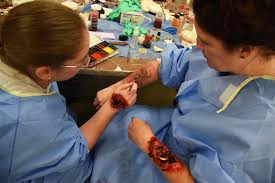The Art and Science of Moulage in Medical Training
What is Moulage in Medicine?
Moulage, originally rooted in the art of wax modeling, has evolved significantly over time. Traditionally, it involved creating lifelike wax models to represent various medical conditions, primarily for educational purposes. Today, moulage refers to the specialized technique of applying realistic makeup and prosthetics to simulate injuries, diseases, and other medical conditions, predominantly in medical training environments.
Understanding Moulage
The term “moulage” comes from the French word for “molding” or “casting.” It captures the essence of creating realistic replicas of wounds, lesions, or other medical conditions that can be used to train healthcare professionals.
These realistic models help bridge the gap between theoretical knowledge and practical skills by providing a lifelike context for learning.
Applications of Moulage in Medical Training
Modern moulage is widely used in medical simulations to prepare healthcare professionals for real-life scenarios. Here are a few examples:
- Injury Simulation: Moulage artists create realistic wounds such as lacerations, burns, and gunshot wounds. These are applied to training manikins or actors, known as standardized patients, to help medical students and professionals practice their response to traumatic injuries.
- Disease Process Replication: Conditions such as diabetic ulcers, dermatological rashes, or infectious diseases can be replicated through moulage. This allows students to identify and treat these conditions in a controlled environment before encountering them in actual patients.
- Surgical Training: Moulage can be used to create realistic surgical sites, helping surgeons practice procedures like suturing, debridement, or complex reconstructive surgery.
The Importance of Moulage in Medical Education
Moulage plays a crucial role in enhancing the realism of medical simulations. It allows trainees to practice their diagnostic and procedural skills in a safe, controlled environment, reducing the risk of errors in real-life situations.
The visual and tactile realism that moulage provides helps create immersive training experiences, which can significantly improve the confidence and competence of medical professionals.
Conclusion
Moulage has transitioned from its origins in wax modeling to a sophisticated tool in modern medical education. By simulating real-life conditions with incredible accuracy, it prepares healthcare professionals to handle a wide range of medical situations with skill and precision. As medical training continues to evolve, the art of moulage will likely remain an integral part of developing the next generation of healthcare providers.




